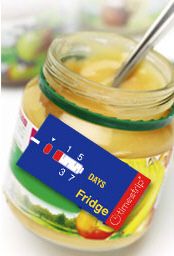If you have ever wondered how long the milk has been open, or that packet of ham in the fridge? Given the amount of packaged food that we have open at any time within our kitchen cupboards, fridges and even freezers it is hardly surprising that we cannot keep track of exactly when everything was opened.
Our quick take
Brilliant, British innovation at its best. A cheap yet effective solution to the problem of food going past its eatable prime.

TimeStrip smart labels - 4.5 / 5
| FOR | AGAINST |
|---|---|
|
|
Consider that not every "best before" is as simple as a date shown on the packaging, what about "eat within 7 days of opening" or "keep refrigerated and consume within a month" type instructions? Put these two variables together and the problem moves beyond the annoying and into healthcare territory. Talking of which, how long has that bottle of medicine been open in the first aid cabinet again?
An innovative new British invention might just have the solution, and like all good ideas it’s a relatively simple technology that has been used to create these smart labels called TimeStrip. Think of them as being visual alarm clocks and you are not far wrong, as each single use, disposable label will automatically measure lapsed time from the moment you pop the bubble seal on the back until the designated timescale is exhausted.
They come in various flavours including fridge strips with a 2 week span, room temperature strips with a 4 month span and freezer strips that last a year. What they all have in common is the way they work, which is simply a matter of good old school lab physics. TimeStrip uses capillary action to allow a tinted liquid to migrate through a micro-porous material at a consistent rate.
This diffusion produces a highly visible red line on the time-window of the label. And as a bonus, because the viscosity of the liquid changes depending upon temperature and so the rate of diffusion changes accordingly, if you leave an item with a fridge TimeStrip out in the kitchen overnight, the increased temperature will speed up the elapsed time. Perfect, considering that the food will go off more quickly when not in the fridge.
The only problem we had was that on the 4 month label, the scale is such that getting an accurate idea in weeks, rather than months, is difficult.
This means that it would be hard to use these where timescales are measured in days. That said, of course, foodstuff stored at room temperature usually lasts for months hence the scale used. Move to the fridge version and the scale is greatly reduced, to 2 weeks, which means that the granularity greatly improves and is just fine for day to day monitoring.
These labels are small, measuring just 40 x 20mm, and versatile courtesy of the self-adhesive backing. They work exactly as described and are easy peasy to use. But best of all they won’t break the bank.
You can buy a pack of 25 TimeStrip labels from the online shopping arm of Waitrose, Ocado.com, for just £1.99 which is just 8p per label. Not much to pay for total peace of mind and an end to tummy aches caused by food that is past its best.
To recap
A label that shows you exactly how long your food or other perishable item has been open
